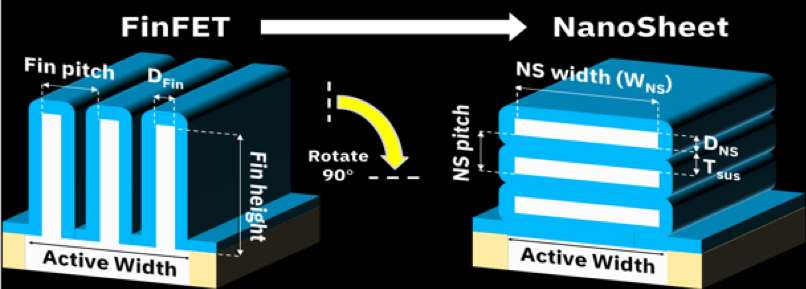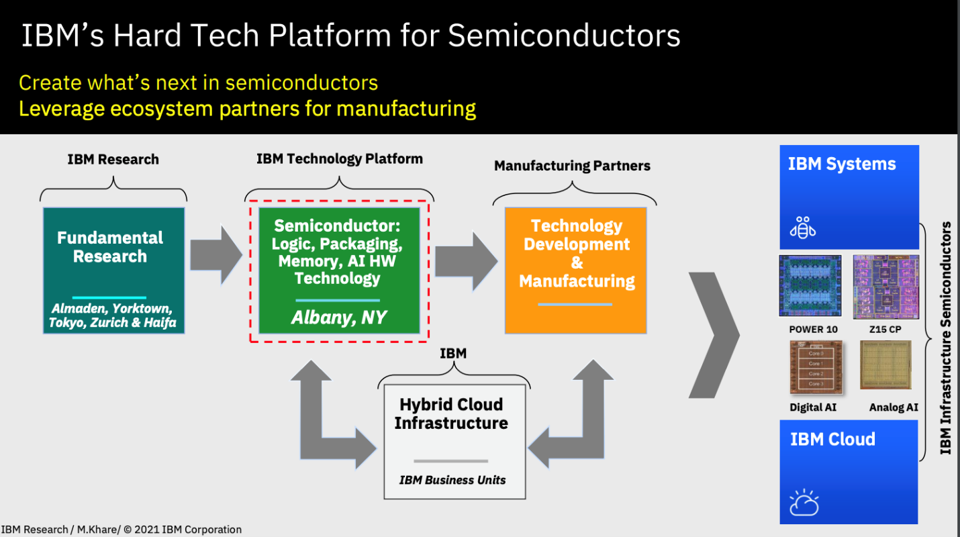
Components smaller than a strand of DNA. Fifty billion transistors on a fingernail-sized chip. The ability to quadruple mobile phone battery life and dramatically speed up compute on laptops or servers. Performance 45% higher, energy use 75% lower than today's "most advanced" 7nm node chips. Those were the headline promises of IBM's world-first 2nm semiconductor transistor design, revealed May 6 and based on its "nanosheet" technology.
But with IBM largely invisible to the average pundit watching the global semiconductor industry, having sold its microelectronics manufacturing unit to GlobalFoundries in 2014, where precisely does Big Blue fit into the ecosystem? What innovations actually underpin this release? And who will make use of them?
The Stack took a closer look.

IBM 2nm: flipping wafers on their sides
IBM's demonstration of a nanosheet transistor for a 2nm chip node is based on several milestones by a research team based out of Albany. A primary one is its innovation in how the elements of a chip are arranged and materials used that was first demonstrated publicly in 2017. This "nanosheet" approach involves stacking layers of silicon together horizontally, rather than using the established "finFET" methods involving vertical architecture. The IBM approach opens a fourth “gate” on the transistor that lets electrical signals pass between other transistors on a chip -- via a switch little larger than a DNA strand on its side.
That involved over a decade's worth of studies on the viability of putting gates all around the transistor ("Gate-All-Around", or GAA) as IBM's Huiming Bu noted in 2017. "Still another key advancement to highlight in the first 2 nm transistor is our development of a new multi-threshold-voltage (Multi-Vt) device offering with leakage levels spanning three orders of magnitude, noted IBM Research's Julien Frougier and Dechao Guo today. "That enables device manufacturers to better choose the level of performance required by the underlying chip architecture."
You can see the full list of "Aha!" moments in their blog here. (As Tom's Hardware notes, however, what's missing is detail on SRAM, density metrics for cell libraries, and the materials it uses for the 2nm node, as well as interconnect scaling -- integrated chips can contain up to 30 miles of interconnect 'wires' that connect transistors and other components, and make them functional. Shrinking these down further remains a challenge.)

Who's making this stuff?
You won't find IBM in Gartner's 2020 top 10 list of chip vendors. That's because... it ain't one. But it has built a thriving semiconductor research ecosystem around public-private partnership that includes IBM itself, New York State, SUNY POLY, and many of the world’s leading semiconductor companies.
IBM has a longstanding manufacturing partnership with Samsung Electronics and looks set to continue with this relationship. In March 2021 IBM and Intel meanwhile also jointly announced plans to team up further on semiconductor R&D -- promising to jointly "advance next-generation logic and packaging technologies" and to "enhance the competitiveness of the U.S. semiconductor industry and support key US government initiatives."
As John Abbott, Principal Research Analyst, S&P Global Market Intelligence’s 451 Research, noted to The Stack: "IBM does have a significant pedigree in processors – but it has primarily designed and manufactured chips for its own proprietary systems, most notably the mainframe – now over 50 years old -- but also for its Power series of enterprise servers. Volumes are small compared to merchant microprocessors, but the systems they power are very high margin and drive a lot of related software and services business for IBM. There have been some consumer-oriented products from IBM that shipped in volume, such as the PowerPC processor (licensed by Motorola and Apple in the 1980s) and the Cell processor (used by Sony for the Playstation in the mid-2000s).
He added: "IBM divested its IBM Microelectronics division in 2014, paying $1.5bn to GlobalFoundries to take it on and continue the necessary investment, committing to a 10 year exclusive supply contract for GF to manufacture IBM chips. IBM has continued with its own chip design and R&D. It does this for two reasons: to maintain its chip roadmaps for the mainframe and Power (using partners to manufacture); and to potentially license its R&D breakthroughs to other chip companies to generate some revenue.
"With GlobalFoundries pulling out of advanced process manufacturing in 2018, IBM has leveraged its relationship with Samsung to manufacture the chips it needs for the latest IBM Z13 mainframes and Power9 servers. The recent R&D agreement with Intel may be an indication that IBM could leverage Intel Foundry Services in the future, with Intel leveraging IBM’s advanced process research in turn.
Asked by The Stack what IBM's plan was for roll-out of the 2nm technology, a spokesperson responded broadly : "We jointly developed the 2nm technology with partners in our semiconductor innovation ecosystem. We'll work with our ecosystem partners for manufacturing options."
Frougier and Guo added in their blog: "Although we’re still several years away from manufacturing of 2nm node devices, IBM Research’s innovations feed directly into our commercial product roadmap.
"Our first commercialized 7nm processor, based on IBM Research’s 2015 breakthrough, will debut later this year in IBM POWER10 processor... Looking ahead, our leadership in semiconductor innovation could allow cloud providers or other large-scale datacenter operators to reduce their energy costs and carbon footprint by using fewer servers to accomplish the same amount of work."
IBM POWER10-based servers will become available in the second half of 2021.
The processors inside them will be made for IBM by Samsung Electronics off IBM's CPU designs, with hardware "co-optimized" for Red Hat OpenShift.
